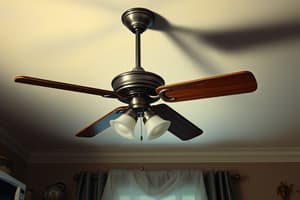Podcast
Questions and Answers
What are some benefits of a ceiling fan? (Select all that apply)
What are some benefits of a ceiling fan? (Select all that apply)
- Beauty (correct)
- Summer cooling (correct)
- Ambient illumination (correct)
- Winter heating (correct)
- Energy savings (correct)
What is a pancake motor?
What is a pancake motor?
Most common type of motor, described by size, diameter vs height.
What is the purpose of bearings in a ceiling fan?
What is the purpose of bearings in a ceiling fan?
They separate moving parts of the motor from the housing and reduce friction and wear.
How is fan efficiency measured?
How is fan efficiency measured?
How do fans create wind chill?
How do fans create wind chill?
What is winter heating in relation to ceiling fans?
What is winter heating in relation to ceiling fans?
What are the factors affecting airflow and long-term fan performance? (Select all that apply)
What are the factors affecting airflow and long-term fan performance? (Select all that apply)
What regulation exists regarding ceiling fan light kits?
What regulation exists regarding ceiling fan light kits?
What factors determine fan sizes?
What factors determine fan sizes?
Flashcards are hidden until you start studying
Study Notes
Benefits of Ceiling Fans
- Summer Cooling: Provide a breeze that enhances comfort during hot weather.
- Winter Heating: Re-circulate warm air from the ceiling to warm the space below.
- Energy Savings: Operate efficiently, leading to reduced energy costs in heating and cooling.
- Ambient Illumination: Often include light fixtures, adding to room brightness.
- Aesthetic Appeal: Available in various designs, enhancing interior decor.
Pancake Motor
- Common Motor Type: Characterized by a smaller height in relation to its diameter, favored for ceiling fans due to its efficiency.
Bearings
- Functionality: Support moving parts in the motor, minimizing friction and wear.
- Self-Lubricating: Most modern bearings are designed to reduce maintenance.
Fan Efficiency
- Labeling: Fans rated based on airflow produced per watt of electricity consumed, indicating energy performance.
Wind Chill Effect
- Airflow Mechanism: Fans create a downward airflow, making the air feel cooler and more comfortable for occupants.
Winter Heating Mechanism
- Re-Circulation Role: Fans help distribute warm air that gathers near the ceiling, improving overall temperature in the room.
Factors Affecting Airflow and Performance
- Motor Speed: Influences how much air is moved.
- Blade Surface Area: Larger blades can move more air.
- Blade Pitch: The angle of blades affects airflow dynamics.
- Blade Sweep Diameter: Diameter of the fan’s rotation impacts the amount of air circulation.
Ceiling Fan Light Kits
- Regulation Requirement: Must come with compact fluorescent lights (CFLs) for medium-based sockets as per federal guidelines.
Fan Sizes
- Importance: Size influences fan performance and appropriateness for specific room dimensions (details not provided).
Studying That Suits You
Use AI to generate personalized quizzes and flashcards to suit your learning preferences.




